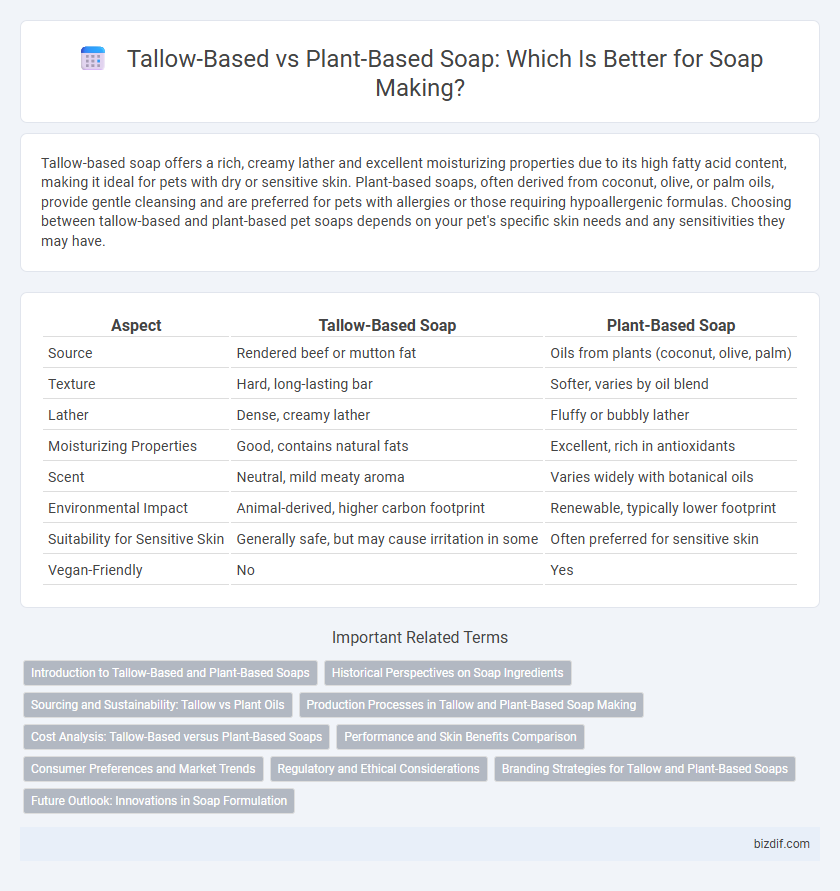Tallow-based soap offers a rich, creamy lather and excellent moisturizing properties due to its high fatty acid content, making it ideal for pets with dry or sensitive skin. Plant-based soaps, often derived from coconut, olive, or palm oils, provide gentle cleansing and are preferred for pets with allergies or those requiring hypoallergenic formulas. Choosing between tallow-based and plant-based pet soaps depends on your pet's specific skin needs and any sensitivities they may have.
Table of Comparison
| Aspect | Tallow-Based Soap | Plant-Based Soap |
|---|---|---|
| Source | Rendered beef or mutton fat | Oils from plants (coconut, olive, palm) |
| Texture | Hard, long-lasting bar | Softer, varies by oil blend |
| Lather | Dense, creamy lather | Fluffy or bubbly lather |
| Moisturizing Properties | Good, contains natural fats | Excellent, rich in antioxidants |
| Scent | Neutral, mild meaty aroma | Varies widely with botanical oils |
| Environmental Impact | Animal-derived, higher carbon footprint | Renewable, typically lower footprint |
| Suitability for Sensitive Skin | Generally safe, but may cause irritation in some | Often preferred for sensitive skin |
| Vegan-Friendly | No | Yes |
Introduction to Tallow-Based and Plant-Based Soaps
Tallow-based soaps, derived from rendered animal fat, offer a dense, creamy lather and excellent moisturizing properties due to their high stearic acid content. Plant-based soaps utilize oils such as olive, coconut, and palm, providing a lighter lather with natural antioxidants and vitamins beneficial for sensitive skin. Both soap types differ in sustainability, with plant-based options favored for eco-friendly and vegan choices, while tallow soaps are praised for their traditional durability and skin nourishment.
Historical Perspectives on Soap Ingredients
Tallow-based soap, derived from animal fat, has been a staple in traditional soap making for centuries due to its rich lather and long-lasting bars, especially prominent in European and early American soap production. Plant-based soaps, using oils such as olive, coconut, or palm, trace their origins to ancient Mediterranean and Middle Eastern cultures, valued for their moisturizing properties and gentler cleansing effects. Historical shifts in soap ingredients reflect both regional agricultural resources and evolving consumer preferences for sustainability and skin sensitivity.
Sourcing and Sustainability: Tallow vs Plant Oils
Tallow, derived from animal fat, is sourced as a byproduct of the meat industry, promoting waste reduction but raising concerns about animal welfare and environmental impact. Plant-based oils, extracted from crops like olive, coconut, and palm, offer renewable and biodegradable alternatives but their cultivation can lead to deforestation, water use, and pesticide reliance. Sustainable sourcing for both tallow and plant oils requires careful consideration of supply chain transparency, ethical farming practices, and ecological footprints to minimize negative environmental effects.
Production Processes in Tallow and Plant-Based Soap Making
Tallow-based soap production involves rendering animal fat through a process of heating and purification to extract fatty acids suitable for saponification, ensuring a dense, moisturizing bar. Plant-based soap making utilizes oils like coconut, olive, or palm, extracted via cold-pressing or solvent extraction methods, preserving natural antioxidants and nutrients for gentle cleansing properties. Both methods require precise control of temperature and lye concentration to achieve optimal soap texture and bar longevity.
Cost Analysis: Tallow-Based versus Plant-Based Soaps
Tallow-based soaps typically offer a lower production cost due to the availability of animal fats as a byproduct of the meat industry, making them economically viable for large-scale manufacturing. Plant-based soaps often incur higher costs because of the premium prices of oils like coconut, olive, or palm, especially when sourced sustainably or organically. Cost efficiency in soap making balances raw material prices, supply chain stability, and consumer demand for natural or ethical ingredients.
Performance and Skin Benefits Comparison
Tallow-based soap delivers superior cleansing power and rich, creamy lather due to its high stearic acid content, providing deep nourishment and moisture retention for dry or sensitive skin. Plant-based soap, crafted from oils like olive, coconut, or shea, offers gentle hydration and antioxidants that promote skin elasticity and soothe irritation, making it ideal for sensitive and combination skin types. Both types vary in hardness and longevity; tallow bars typically last longer and maintain shape, while plant-based soaps excel in delivering natural vitamins and are preferred for vegan skincare.
Consumer Preferences and Market Trends
Tallow-based soaps, valued for their rich lather and moisturizing properties, appeal to consumers seeking traditional and natural skincare products with animal-derived ingredients. Plant-based soaps are increasingly preferred by eco-conscious buyers and vegans, driven by rising demand for sustainable and cruelty-free options. Market trends indicate a strong growth in plant-based formulations, reflecting shifting consumer priorities toward environmental impact and ethical sourcing.
Regulatory and Ethical Considerations
Tallow-based soap production faces stricter regulatory scrutiny due to animal welfare laws and sourcing transparency requirements, whereas plant-based soaps benefit from certifications like USDA Organic and Fair Trade, enhancing market appeal. Ethical considerations emphasize sustainability and cruelty-free practices, with plant-based ingredients reducing carbon footprints and addressing vegan consumer demands. Compliance with labeling standards and supply chain traceability is critical for both types to ensure consumer trust and avoid legal penalties.
Branding Strategies for Tallow and Plant-Based Soaps
Tallow-based soap branding emphasizes tradition, durability, and natural animal fats, appealing to consumers seeking classic, high-moisture cleansing with environmental benefits linked to byproduct use. Plant-based soap branding focuses on ethical sourcing, vegan lifestyles, and sustainability, targeting health-conscious and eco-friendly markets through natural botanical ingredients and cruelty-free messaging. Both strategies require highlighting unique benefits such as skin nourishment for tallow soaps versus hypoallergenic and vibrant scents for plant-based options to effectively differentiate and capture niche consumer bases.
Future Outlook: Innovations in Soap Formulation
Tallow-based soap formulations are being enhanced with sustainable sourcing and advanced refining techniques to improve skin benefits and reduce environmental impact. Plant-based soap innovations focus on incorporating bioactive botanicals and biodegradable surfactants to meet growing consumer demand for cruelty-free and eco-friendly products. Emerging technologies such as enzymatic saponification and microencapsulation promise to optimize ingredient stability and enhance fragrance release, shaping the future of soap formulation.
Tallow-based vs Plant-based Infographic

 bizdif.com
bizdif.com